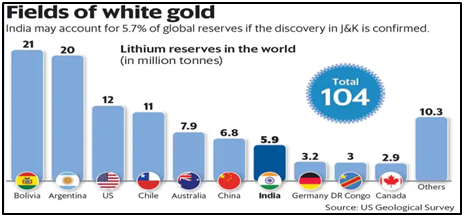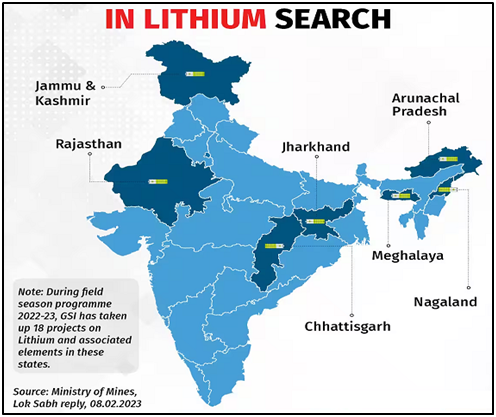Why in News?
- The news of potentially significant reserves of lithium in J&K and Rajasthan in India has been welcomed universally.
What’s in Today’s Article?
- About Lithium
- Lithium Reserves in India
- Why Access to or Control over Lithium is Important?
- Who Should Own these Minerals?
- How do Other Countries Manage Lithium Reserves?
- Way Ahead for India
About Lithium:
- It is a soft, silvery-white non-ferrous metal and is one of the key components in rechargeable batteries for mobile phones, laptops, digital cameras and electric vehicles.
- It is also used in some non-rechargeable batteries for things like heart pacemakers, toys and clocks.
Lithium Reserves in India:
- The Geological Survey of India (GSI) had for the first time in India's history established Lithium inferred resources of 5.9 million tonnes in Jammu and Kashmir’s Reasi district.

- Months after India's first lithium reserves, the GSI has found another reserve of the crucial mineral in Degana in Rajasthan's Nagaur district.
- These reserves are believed to be much bigger in quantity (than found in J&K) and can meet 80% of the total country's demand.

Why Access to or Control over Lithium is Important?
- India’s electric-vehicle (EV) market was valued at $383.5 million in 2021, and is expected to expand to $152.21 billion in 2030.
- India imported 450 million units of lithium batteries valued at $929.26 million (₹6,600 crore) in 2019-2020.
- The ongoing global transition to low-carbon economies, the rapid expansion of artificial intelligence (AI), and 5G networks will greatly reshape global and regional geopolitics.
Who Should Own these Minerals?
- Private ownership: In 2013, the Supreme Court of India ruled that the owner of the land has rights to everything beneath.
- Public ownership: Forests (which make up more than 22% of India’s landmass), hills, mountains, and revenue wasteland are publicly owned.
- Ownership of Lithium: According to the SC, the Union government could ban private actors from mining sensitive minerals, as is already the case with uranium under the Atomic Energy Act 1962.
- In today’s context, lithium is as important as uranium.
How do Other Countries Manage Lithium Reserves?
- In Chile, the government has designated lithium as a strategic resource and its development has been made the exclusive prerogative of the state.
- A new “National Lithium Strategy” (2023) attempts to regulate the environmental impact of lithium-mining, distribute revenue more fairly among local communities, and promote lithium-based green technologies.
- Bolivia’s new constitution gave the state “the control and direction over the exploration, exploitation, industrialisation, transport, and commercialisation of natural resources.”
- This is believed to be one of the factors for the country’s failure to produce any lithium at a commercial scale.
- The new government wants to join hands with other Latin American countries to design a ‘lithium policy’ that would benefit all their economies.
- Mexico also nationalised lithium, declaring, “Oil and lithium belong to the nation, they belong to the people of Mexico.”
Way Ahead for India:
- Much of India’s mineral wealth is mined from regions with very high levels of poverty, environmental degradation, and lax regulation.
- Effective and careful management of the sector should be paramount if India’s rare minerals development is to meet its multiple goals - social wellbeing, environmental safety, and national energy security.











